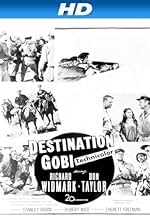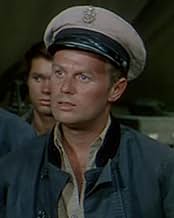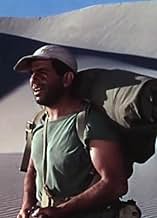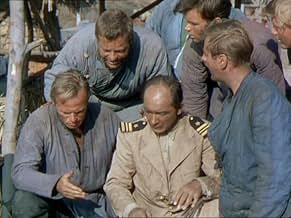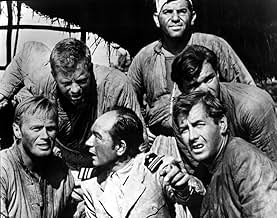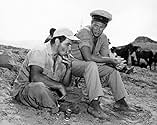VALUTAZIONE IMDb
6,3/10
1216
LA TUA VALUTAZIONE
Aggiungi una trama nella tua linguaIn 1944, US Navy specialists run a weather station in the Gobi desert where they are harassed by Japanese warplanes but aided by local Mongol nomads.In 1944, US Navy specialists run a weather station in the Gobi desert where they are harassed by Japanese warplanes but aided by local Mongol nomads.In 1944, US Navy specialists run a weather station in the Gobi desert where they are harassed by Japanese warplanes but aided by local Mongol nomads.
- Regia
- Sceneggiatura
- Star
Max Showalter
- Walter Landers
- (as Casey Adams)
Edgar Barrier
- Yin Tang
- (non citato nei titoli originali)
Willis Bouchey
- Capt. Gates
- (non citato nei titoli originali)
James Conaty
- Admiral
- (non citato nei titoli originali)
Franklyn Farnum
- Quartermaster General
- (non citato nei titoli originali)
John Hedloe
- Pilot
- (non citato nei titoli originali)
Earl Holliman
- Frank Swenson
- (non citato nei titoli originali)
Frank Iwanaga
- Lieutenant
- (non citato nei titoli originali)
Recensioni in evidenza
The title suggests something more rugged. But for once they weren't joking when the opening crawl declared this "one of the strangest stories of World War II" (although they probably were when they cast Mervyn Vye as the leader of "the First Mongolian Cavalry". While another of the locals is a kleptomaniac nicknamed 'Harpo' who like his namesake communicates through mime).
The tale of "a bunch of weathermen chasing balloons" across Inner Mongolia, the most arduous part of shooting Robert Wise's first colour film was probably lugging the enormous Technicolor camera about; which paradoxically makes it incongruously pretty to contemplate.
The tale of "a bunch of weathermen chasing balloons" across Inner Mongolia, the most arduous part of shooting Robert Wise's first colour film was probably lugging the enormous Technicolor camera about; which paradoxically makes it incongruously pretty to contemplate.
My father was a part of this group, they were actually called SACO. He liked this movie, thought it was somewhat accurate. He was a Navy Chief Petty Officer, a Medic, he loved Mongolia, it reminded him of Montana, where he grew up, and he admired the people. He liked the humor in it. They were actually a sort of obscure, almost "guerilla" group. Kind of like Navy Calvary. I thought it was called "Saddles for SACO", (maybe another earlier title?). He always felt it was a great mistake to underestimate the indigenous people, he used to use Mr.Custer as an example. All the West Point training or Annapolis , for that , purpose , may not help you in the end.And he told me, all Americans think they're John Wayne, unfortunately, those ponies didn't always know.
There were a lot of WW2 pictures made in the late 40s and early 50s, made as uncomplicated gung-ho nostalgia, doubling as propaganda for the ongoing war in Korea. By and large they were cheap and cheerful affairs; poorly scripted and poorly acted. Destination Gobi is just such a picture, its main exception being that it is somewhat spruced up by the direction of the great Robert Wise.
Being relatively low-budget Destination Gobi is rather short on action, instead relying upon suspense sequences and musings on military life for its entertainment value. Sadly the screenplay isn't quite up to the task. There is a sprinkling of quasi-philosophical dialogue, most of which is feeble and unconvincing (the only line I liked was the one about Inner Mongolia being "hotter, dryer and inner"). The characters are the usual B-movie one-dimensionals, and many scenes are so lacking in credibility the tension can't work because there is no real sense of danger.
This is where Robert Wise comes in. It's often interesting, albeit dissatisfying, to see a really top-notch director slumming it in a B-unit to see what they can make out of the weakest of elements. This is especially true of Wise, who had no ego and always aimed to make the best out of whatever the studios threw at him. This is his first colour picture and, as far as I know his earliest to really make use of wide-open spaces. Most of Wise's pictures up until now had been gritty thrillers, and even his 1948 horse opera Blood on the Moon is literally a dark Western. It's been remarked by others that the landscape in Destination Gobi is filmed to show off its beauty, but also watch Wise's timing. It would be normal convention to cut to a landscape shot after the opening scene at SACO HQ, but in fact Wise takes care not to properly show us the desert and emphasises the smallness and darkness of the tent. Only after the Mongols have been introduced do we get these breathtaking outdoor shots. The contrast is striking and it makes us associate the Mongols with the beauty of the location, even if only subconsciously.
I am sure Wise knew he had been given a bum script, and he takes advantage of the quiet moments. Wise's direction was generally at its best when there was no dialogue anyway (check out Lawrence Tierney in Born to Kill) and he particularly seemed to like drawing out these moments and giving the actors space to emote. Consequently there is tenderness uncharacteristic of such a picture when the soldiers mourn a fallen comrade, opening the scene with a respectful long shot of the gravesite. Again the natural beauty of the landscape is used, this time as a bittersweet counterpoint.
The cast is headed by Richard Widmark, who like Wise was good at what he did yet spent much of his career in B-flicks. And, as with Wise, we can look at this positively and say that he at least leant some quality to pictures that have very little else going for them. He can't quite make the appalling dialogue sound plausible, but at least he emotes well and has strong presence. The Mongol characters may not be granted any dignity by the screenplay, but at least the reliable Murvyn Vye turns in a dignified performance as Chief Kengtu, adding a layer of personality to the character that is not there in the script.
These little oases of quality do not prevent Destination Gobi from mostly being a desert of mediocrity. Studying Robert Wise's work, this is like a little exercise in thoughtful direction, but nothing more because there isn't enough depth to the story or characters to make it pay off. And who would expect more from a ninety-minute no-brainer? However, at least the efforts of Wise (as well as renowned art directors Lyle Wheeler and Lewis Creber, and cinematographer Charles Clarke well-deserved honourable mentions) have made it nice to look at. It's occasionally even entertaining as well.
Being relatively low-budget Destination Gobi is rather short on action, instead relying upon suspense sequences and musings on military life for its entertainment value. Sadly the screenplay isn't quite up to the task. There is a sprinkling of quasi-philosophical dialogue, most of which is feeble and unconvincing (the only line I liked was the one about Inner Mongolia being "hotter, dryer and inner"). The characters are the usual B-movie one-dimensionals, and many scenes are so lacking in credibility the tension can't work because there is no real sense of danger.
This is where Robert Wise comes in. It's often interesting, albeit dissatisfying, to see a really top-notch director slumming it in a B-unit to see what they can make out of the weakest of elements. This is especially true of Wise, who had no ego and always aimed to make the best out of whatever the studios threw at him. This is his first colour picture and, as far as I know his earliest to really make use of wide-open spaces. Most of Wise's pictures up until now had been gritty thrillers, and even his 1948 horse opera Blood on the Moon is literally a dark Western. It's been remarked by others that the landscape in Destination Gobi is filmed to show off its beauty, but also watch Wise's timing. It would be normal convention to cut to a landscape shot after the opening scene at SACO HQ, but in fact Wise takes care not to properly show us the desert and emphasises the smallness and darkness of the tent. Only after the Mongols have been introduced do we get these breathtaking outdoor shots. The contrast is striking and it makes us associate the Mongols with the beauty of the location, even if only subconsciously.
I am sure Wise knew he had been given a bum script, and he takes advantage of the quiet moments. Wise's direction was generally at its best when there was no dialogue anyway (check out Lawrence Tierney in Born to Kill) and he particularly seemed to like drawing out these moments and giving the actors space to emote. Consequently there is tenderness uncharacteristic of such a picture when the soldiers mourn a fallen comrade, opening the scene with a respectful long shot of the gravesite. Again the natural beauty of the landscape is used, this time as a bittersweet counterpoint.
The cast is headed by Richard Widmark, who like Wise was good at what he did yet spent much of his career in B-flicks. And, as with Wise, we can look at this positively and say that he at least leant some quality to pictures that have very little else going for them. He can't quite make the appalling dialogue sound plausible, but at least he emotes well and has strong presence. The Mongol characters may not be granted any dignity by the screenplay, but at least the reliable Murvyn Vye turns in a dignified performance as Chief Kengtu, adding a layer of personality to the character that is not there in the script.
These little oases of quality do not prevent Destination Gobi from mostly being a desert of mediocrity. Studying Robert Wise's work, this is like a little exercise in thoughtful direction, but nothing more because there isn't enough depth to the story or characters to make it pay off. And who would expect more from a ninety-minute no-brainer? However, at least the efforts of Wise (as well as renowned art directors Lyle Wheeler and Lewis Creber, and cinematographer Charles Clarke well-deserved honourable mentions) have made it nice to look at. It's occasionally even entertaining as well.
I saw Destination Gobi in 1953. I looked for a copy of the movie for years until I was able to get it on DVD. I have watched this movie several times since, and enjoy each viewing.
I differ from some of the more critical reviews. Too often the reviews come off as the "want-to- be movie critics", who seem to nitpick this and that. They fail to recognize that some movies are meant for just entertainment. Destination Gobi falls into this category. It wasn't meant to become Movie of the Year, nor to compete with Gone With the Wind.
I have most of the war movies made in my DVD library. World War II created many Hollywood opportunities in creating movies, along with governmental approval to boost patriotism. And, Hollywood produced many, some great, others poor. Movie goers liked some, disliked others. It's just a matter of one's own personal view of what they're looking for in a film. If it's for their desire to have an opportunity to become a pseudo-movie critic, then so be it. I watch movies for entertainment
I differ from some of the more critical reviews. Too often the reviews come off as the "want-to- be movie critics", who seem to nitpick this and that. They fail to recognize that some movies are meant for just entertainment. Destination Gobi falls into this category. It wasn't meant to become Movie of the Year, nor to compete with Gone With the Wind.
I have most of the war movies made in my DVD library. World War II created many Hollywood opportunities in creating movies, along with governmental approval to boost patriotism. And, Hollywood produced many, some great, others poor. Movie goers liked some, disliked others. It's just a matter of one's own personal view of what they're looking for in a film. If it's for their desire to have an opportunity to become a pseudo-movie critic, then so be it. I watch movies for entertainment
Likeable American war movie about a group of valiant sailors who escape through the Gobi desert .The surprising tale of Uncle Sam's "sailors on camels" , a little US naval detachment who battled throughout the Mongolian desert. Along the way the sailors attempt to engage local the Mongol tribesman to attack Japanese ; but things go wrong when those respond by bombing the station .Set in 1944 inner Mongolia , where a team of US Navy specialists run a weather station , they are forced to a marathon trek across the sunny desert where are harassed and attacked by Japanese warplanes , taken prisoners , but helped by local Mongol nomads whom deliver 60 horse saddles and become them into an expert Mongolian cavalry .
This a sympathetic movie in which interest and entertainment never fall . The screenplay contains implausible adventures , goodhumoured scenes , tongue-in-cheek excitement , agreeable situations with the laughs in the right places .Widmark plays an US Navy officer assigned to take charge a bunch of meteorologistics at a remote weather station , when a Japanese attack leaving to him and his company alone in the wilderness to fend for themselves , Richard gives the film enough security and authority . And he is backed by a magnificent cast that includes Don Taylor , Russell Collins , Murvyn Vye , Casey Adams , Willis Bouchey , Darryl Hickman , Rodolfo Acosta , Richard Loo and Earl Holliman , Martin Milner film debut . And Paiute Indians living in reservation where was shot the movie played Mongol extras .
Musical score from Alfred Newman and Sol Kaplan is highly commendable. Colorful cinematography in Technicolor by Charles Clarke , being Wise's first color movie . Being filmed on location in Nixon and Fallon and other Indians reservation . Produced and released by 2oth century Fox and well directed by Robert Wise who never lets the action sag .Wise was a good director who made films in all kinds of genres , nowadays , some of them considered classic movies , such as : Musical : West side story , The sound of music ; SciFi: The day the Earth stood , Andromeda strain , Star Trek the motion picture ; Terror : The haunting , The body snatchers, , Audrey Rose , Curse of cat people ; Wartime : Run silent Run deep , The Desert Rats ; Historical : Helen of Troy ; Western : Tribute to a bad man ; Drama : I want to live , The Set-up , among others
This a sympathetic movie in which interest and entertainment never fall . The screenplay contains implausible adventures , goodhumoured scenes , tongue-in-cheek excitement , agreeable situations with the laughs in the right places .Widmark plays an US Navy officer assigned to take charge a bunch of meteorologistics at a remote weather station , when a Japanese attack leaving to him and his company alone in the wilderness to fend for themselves , Richard gives the film enough security and authority . And he is backed by a magnificent cast that includes Don Taylor , Russell Collins , Murvyn Vye , Casey Adams , Willis Bouchey , Darryl Hickman , Rodolfo Acosta , Richard Loo and Earl Holliman , Martin Milner film debut . And Paiute Indians living in reservation where was shot the movie played Mongol extras .
Musical score from Alfred Newman and Sol Kaplan is highly commendable. Colorful cinematography in Technicolor by Charles Clarke , being Wise's first color movie . Being filmed on location in Nixon and Fallon and other Indians reservation . Produced and released by 2oth century Fox and well directed by Robert Wise who never lets the action sag .Wise was a good director who made films in all kinds of genres , nowadays , some of them considered classic movies , such as : Musical : West side story , The sound of music ; SciFi: The day the Earth stood , Andromeda strain , Star Trek the motion picture ; Terror : The haunting , The body snatchers, , Audrey Rose , Curse of cat people ; Wartime : Run silent Run deep , The Desert Rats ; Historical : Helen of Troy ; Western : Tribute to a bad man ; Drama : I want to live , The Set-up , among others
Lo sapevi?
- QuizNixon and Fallon, NV were both used as location sites, and Paiute Indians residing on a reservation in Nixon played Mongol extras.
- BlooperMcHale claims that "Gobi Desert" means "wall of spears." Actually, "Gobi" is the Mongolian word for "desert."
- Citazioni
[Walter flirts successfully with a Mongolian woman]
Jenkins: Well, looks like you made a hit, Walter my boy. Tell me, how do you do it?
Walter Landers: My training as a meterorologist. I can take one look at a girl and tell weather.
- Curiosità sui creditiOpening credits prologue: In the Navy records in Washington, there is an obscure entry reading "Saddles for Gobi."
This film is based on the story behind that entry--one of the strangest stories of World War II.
- ConnessioniEdited into All This and World War II (1976)
I più visti
Accedi per valutare e creare un elenco di titoli salvati per ottenere consigli personalizzati
- How long is Destination Gobi?Powered by Alexa
Dettagli
Botteghino
- Budget
- 1.340.000 USD (previsto)
- Tempo di esecuzione1 ora 30 minuti
- Colore
- Proporzioni
- 1.37 : 1
Contribuisci a questa pagina
Suggerisci una modifica o aggiungi i contenuti mancanti

Divario superiore
By what name was Destinazione Mongolia (1953) officially released in India in English?
Rispondi

